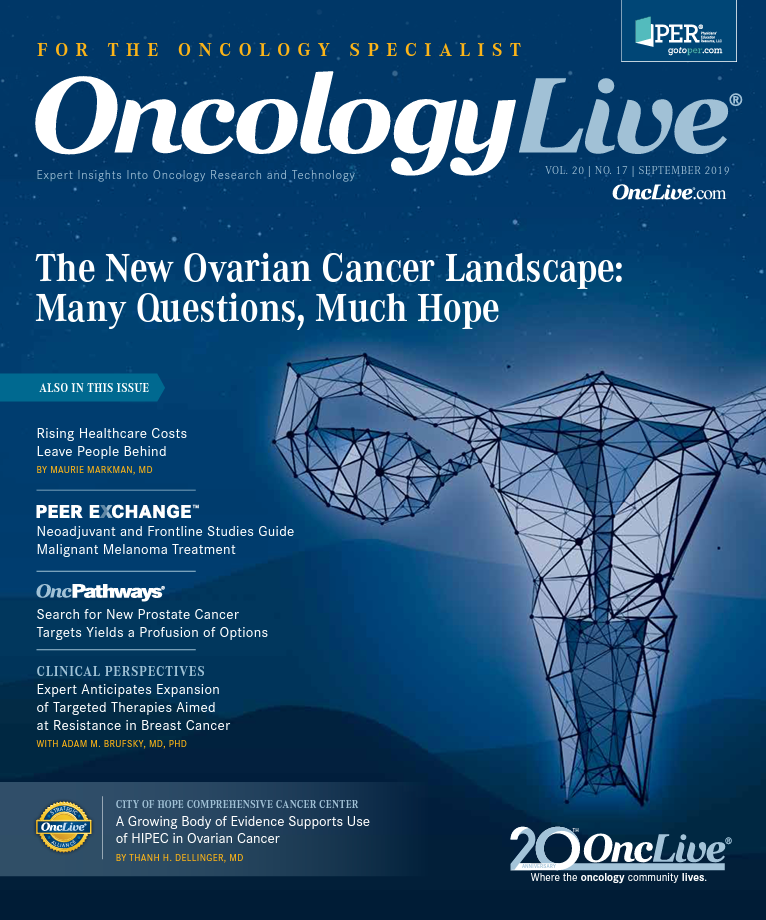Publication
Article
Oncology Live®
Rising Healthcare Costs Leave People Behind
Author(s):
The cost of antineoplastic therapy and essential supportive care medications have a substantial negative impact on patients with cancer and their families.

Maurie Markman, MD
In a most unsettling short story, “The Ones Who Walk Away From Omelas,” Ursula K. Le Guin describes a utopian city and the environment it offers its citizens: “A boundless and generous contentment, a magnanimous triumph felt not against some outer enemy but in communion with the finest and fairest in the souls of all men everywhere and the splendor of the world’s summer: This is what swells the hearts and the people of Omelas, and the victory they celebrate is that of life.”1
This fictional town of prosperity and good humor has a dark secret, one in common with our healthcare system: the woeful circumstances of a minority.
“In a basement…or perhaps in the cellar of one of its spacious private homes, there is a room….In the room a child is sitting.…The door is always locked…”1
What follows is a truly haunting description of the child’s circumstances. The citizens of Omelas know what will happen if they intervene: “If the child were brought up into the sunlight out of that vile place, if it were cleaned and fed and comforted, that would be a good thing, indeed; but if it were done, in that day and hour all the prosperity and beauty and delight of Omelas would wither and be destroyed. Those are the terms.”1
This terribly disturbing and poignant story could have been written as a cautionary tale about the unrelenting acceleration in the costs of beneficial pharmaceutical agents. A recently introduced, potentially highly beneficial gene therapy for a neuromuscular disease is priced at $2.1 million dollars,2 full treatment costs associated with chimeric antigen receptor (CAR) T drug costs are potentially in the range of $1 million, and pharmaceutical companies continue to raise prices of established drugs, with 1 study noting that recently “20 companies increased the list prices of over 40 prescription drugs an average of 13.1%.”3 What can one say?
Another report stated that the mean price per fill in 2010 of 13 oral anticancer drugs covered by Medicare Part D was $7438, and in 2018, these same agents had a mean price per fill of $13,992, an 88% increase in this 8-year time span.4 Further, this report indicated that “in 2018, 48 of 54 medications had monthly prices exceeding $10,000 per fill and 21 had prices exceeding $15,000 per fill.” Finally, out-of-pocket spending increased by 19% for 12 of 13 orally administered drugs between 2010 and 2019, to $10,470 per year.
Apparently acceptable in the current political and regulatory environment, stunningly flagrant drug pricing abuses for generic antibiotics include the decision by a company that acquired exclusive US rights to pyrimethamine (Daraprim) to raise the price of a single tablet to $750 from $13.50. Another organization increased the price for a 30-day supply of the anti-tuberculosis drug cycloserine (Seromycin) to $10,800 from $480.5
It is increasingly recognized and documented that the cost of antineoplastic therapy and essential supportive care medications have a substantial negative impact on patients with cancer and their families. The Cancer Care Outcomes Research and Surveillance study noted that 40% and 33% of patients with lung and colorectal cancer, respectively, experienced what were defined as “limited financial reserves.” Importantly, the analysis revealed that, compared with individuals with more resources, this population experienced greater pain, symptom burden, and inferior quality of life.6
Another way to examine the impact of the escalation in the cost of antineoplastic therapy for individuals and society is to consider a single relatively common malignancy. For example, 1 recently reported study estimated that by 2025, there will be 199,000 individuals in the United States with chronic lymphocytic leukemia (CLL), up from 128,000 in 2011.7 The total cost of CLL care was projected to increase 590% between 2011 and 2025 (from $0.74 billion to $5.13 billion). For individuals, the lifetime cost of care for patients initiating oral therapy in 2016 was projected to be $604,000, up 310% from $147,000 for patients who started therapy in 2011.
The future of the economics of pharmaceutical therapy may not show any improvement. Multiple companies are investing billions of dollars in gene therapies projected to be priced at more than “several million dollars per treatment.”8 In the oncology arena, the delivery of combinations of novel antineoplastic agents is likely to become the norm.
Although investigative efforts exploring CAR T therapy are now relatively narrowly restricted to the hematologic malignancies, what happens if we overcome the existing barriers to CAR T-cell efficacy in the solid tumor arena?9 Will $1 million—plus antineoplastic drug therapy care costs become the suggested standard of care in these vastly expanded patient populations?
Finally, we return to the theme from Omelas. Despite the oppressive financial impact on members of our society and the likelihood that an increasing number of individuals with cancer will be unable to receive the potential benefits of major therapeutic advances, will we as an oncology community treat these as not our concern as long as we and our families are not among this group (“the child in the room”)? By oncology community, I mean basic scientists, clinicians and translational laboratory investigators, patient advocacy groups, pharmaceutical and biotech companies, and others.
Or will we, as a community, receive essential support from political and health policy leaders and governmental regulators and finally begin to actively and effectively work together to find rational solutions so that the revolutionary changes in our understanding of cancer biology, which are leading to increasingly effective approaches to disease management, can ultimately be shared by all without causing financial ruin to individual families and our society?
References
- Le Guin UK. The ones who walk away from Omelas. In The Wind’s Twelve Quarters and The Compass Rose. London, UK: Orion Publishing Group; 1975:254-262.
- News at a glance. Science. 2019;364(6443):808-8010. doi: 10.1126/science.364.6443.808.
- Hopkins JS. Drugmakers push their prices higher. Wall Street Journal. wsj.com/articles/drugmakers-push-their-prices-higher-11562024649. Published July 1, 2019. Accessed August 14, 2019.
- Dusetzina SB, Huskamp HA, Keating NL. Specialty drug pricing and out-of-pocket spending on orally administered anticancer drugs in Medicare Part D, 2010 to 2019. JAMA. 2019;321(20):2025-2027. doi: 10.1001/jama.2019.4492.
- Shoham S, Antar AA, Auwaerter PG, Durand CM, Sulkowski MS, Cotton DJ. Antimicrobial access in the 21st century: delays and critical shortages. Ann Intern Med. 2016;165(1):53-54. doi: 10.7326/M15-3076.
- Lathan CS, Cronin A, Tucker-Seeley R, Zafar SY, Ayanian JZ, Schrag D. Association of financial strain with symptom burden and quality of life for patients with lung or colorectal cancer. J Clin Oncol. 2016;34(15):1732-1740. doi: 10.1200/JCO.2015.63.2232.
- Chen Q, Jain N, Ayer T, et al. Economic burden of chronic lymphocytic leukemia in the era of oral targeted therapies in the United States. J Clin Oncol. 2017;35(2):166-174. doi: 10.1200/JCO.2016.68.2856.
- Orkin SH, Reilly P. Paying for future success in gene therapy. Science. 2016;352(6289):1059-1061. doi: 10.1126/science.aaf4770.
- Ma L, Dichwalkar T, Chang JYH, et al. Enhanced CAR-T cell activity against solid tumors by vaccine boosting through the chimeric receptor. Science. 2019;365(6449):162-168. doi: 10.1126/science.aav8692.




























%20(2)%201-Recovered-Recovered-Recovered-Recovered-Recovered-Recovered-Recovered-Recovered-Recovered-Recovered-Recovered-Recovered-Recovered-Recovered-Recovered-Recovered-Recovered.jpg?fit=crop&auto=format)
%20(2)%201-Recovered-Recovered-Recovered-Recovered-Recovered-Recovered-Recovered-Recovered-Recovered-Recovered-Recovered-Recovered-Recovered-Recovered-Recovered-Recovered-Recovered.jpg?fit=crop&auto=format)
